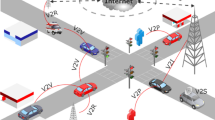Abstract
Vehicular Ad-Hoc Networks (VANET) are a special type of network where its nodes are vehicles that move according to specific patterns. This network is based on wireless communication, presenting new challenges, such as how it will be tested in realistic scenarios. Currently, simulations are widely used. However, they have limitations, such as local minima. Another approach is model checking, which has been used in only a few studies, often overlooking mobility and signal propagation issues. This work provides a realistic mobility model using probabilistic model checking to describe an overtake scenario involving three vehicles in a short distance. Our analysis has shown 98 % of accident chance in this situation. However, the main result is providing an example to represent the mobility aspect which can be connected with other models such as signal propagation and the network itself. Therefore, VANETs can now be tested using methods closer to the reality.
Access this chapter
Tax calculation will be finalised at checkout
Purchases are for personal use only
Preview
Unable to display preview. Download preview PDF.
Similar content being viewed by others
References
Alves, R., et al.: Redes veiculares: Princípios, aplicações e desafios. In: Minicursos do Simpósio Brasileiro de Redes de Computadores, SBRC 2009 (May 2009)
Bai, F., Krishnan, H., Sadekar, V., Holland, G., Elbatt, T.: Towards characterizing and classifying communication-based automotive app. from a wireless networking perspective. In: Proc. of IEEE Workshop on Automotive Networking (2006)
Boban, M., Vinhoza, T.T.V.: Modeling and simulation of vehicular networks: Towards realistic and efficient models. In: Mobile Ad-Hoc Networks: Applications. Intech (2011)
Bouassida, M.S., Shawky, M.: A cooperative congestion control approach within vanets: formal verification and performance evaluation. EURASIP J. Wirel. Commun. Netw., 1–12 (2010)
Boulis, A., Fehnker, A., Fruth, M., McIver, A.: Cavi - simulation and model checking for wireless sensor networks. In: 5th International QEST 2008. QEST (2008)
Choffnes, D.R., Bustamante, F.E.: An integrated mobility and traffic model for vehicular wireless networks. In: Laberteaux, K.P., Hartenstein, H., Johnson, D.B., Sengupta, R. (eds.) Vehicular Ad Hoc Networks, pp. 69–78. ACM (2005)
Christian, A.: Reliable model checking for wsns. In: Proc. of the 8th GI/ITG KuVS Fachgesprach (2009)
Clarke, E., Grumberg, O., Peled, D.: Model Checking. MIT Press (1999)
Dirk Helbing, T., Martin, A.K.: General lane-changing model mobil for car-following models. In: Transp. Research Record: Journal of the Transp. Research Board, pp. 86–94. Transp. Research Board of the National Academies (2007)
Ferreira, B.: http://www.dcc.ufmg.br/~bruno.ferreira/sbmf2014/
Ferreira, M., Fernandes, R., Conceição, H., Viriyasitavat, W., Tonguz, O.K.: Self-organized traffic control. In: Proc. of the 7th ACM International Workshop on VehiculAr InterNETworking, VANET 2010. ACM, New York (2010)
Gipps, P.G.: A model for the structure of lane-changing decisions. Transportation Research Part B: Methodological 20(5), 403–414 (1986)
Harri, J., Filali, F., Bonnet, C.: Mobility models for vehicular ad hoc networks: a survey and taxonomy. IEEE Communications Surveys & Tutorials 11, December 2009
Hartenstein, H., Laberteaux, K., Ebrary, I.: VANET: vehicular applications and inter-networking technologies. Wiley Online Library (2010)
Helbing, D.: Traffic and related self-driven many-particle systems. Rev. Mod. Phys. 73, 1067–1141 (2001)
Kesting, A., Treiber, M., Helbing, D.: Enhanced intelligent driver model to access the impact of driving strategies on traffic capacity. Royal Society of London Philosophical Transactions Series A 368, 4585–4605 (2010)
Khosroshahy, M.: IEEE 802.11 and propagation modeling: A survey and a practical design approach (2007)
Kwiatkowska, M., Norman, G.: PRISM - Property Specification (2011). http://www.prismmodelchecker.org/manual/ (accessed January 28, 2014)
Kwiatkowska, M., Norman, G., Parker, D.: PRISM 4.0: verification of probabilistic real-time systems. In: Gopalakrishnan, G., Qadeer, S. (eds.) CAV 2011. LNCS, vol. 6806, pp. 585–591. Springer, Heidelberg (2011)
Lomuscio, A., Strulo, B., Walker, N.G., Wu, P.: Model checking optimisation based congestion control algorithms. Fundam. Inf. 102(1), January 2010
Althoff, M., Stursberg, O., Buss, M.: Safety assessment of driving behavior in multi-lane traffic for autonomous vehicles. In: Proc. of the IEEE Intelligent Vehicles Symposium, Shaanxi, China (June 2009)
Mangharam, R., Weller, D.S., Stancil, R., Parikh, J.S.: Groovesim: a topography accurate simulator for geographic routing in vanet. In: Vehicular Ad Hoc Networks, pp. 59–68. ACM (2005)
Parker, D.: Implementation of Symbolic Model Checking for Probabilistic Systems. Ph.D. thesis, University of Birmingham (2002)
Treiber, M., Hennecke, A., Helbing, D.: Congested traffic states in empirical observations and microscopic simulations. Rev. E 62(62), 2000 (2000)
Author information
Authors and Affiliations
Corresponding author
Editor information
Editors and Affiliations
Rights and permissions
Copyright information
© 2015 Springer International Publishing Switzerland
About this paper
Cite this paper
Ferreira, B., Braz, F.A.F., Campos, S.V.A. (2015). A Probabilistic Model Checking Analysis of a Realistic Vehicular Networks Mobility Model. In: Braga, C., Martí-Oliet, N. (eds) Formal Methods: Foundations and Applications. SBMF 2014. Lecture Notes in Computer Science(), vol 8941. Springer, Cham. https://doi.org/10.1007/978-3-319-15075-8_8
Download citation
DOI: https://doi.org/10.1007/978-3-319-15075-8_8
Published:
Publisher Name: Springer, Cham
Print ISBN: 978-3-319-15074-1
Online ISBN: 978-3-319-15075-8
eBook Packages: Computer ScienceComputer Science (R0)




